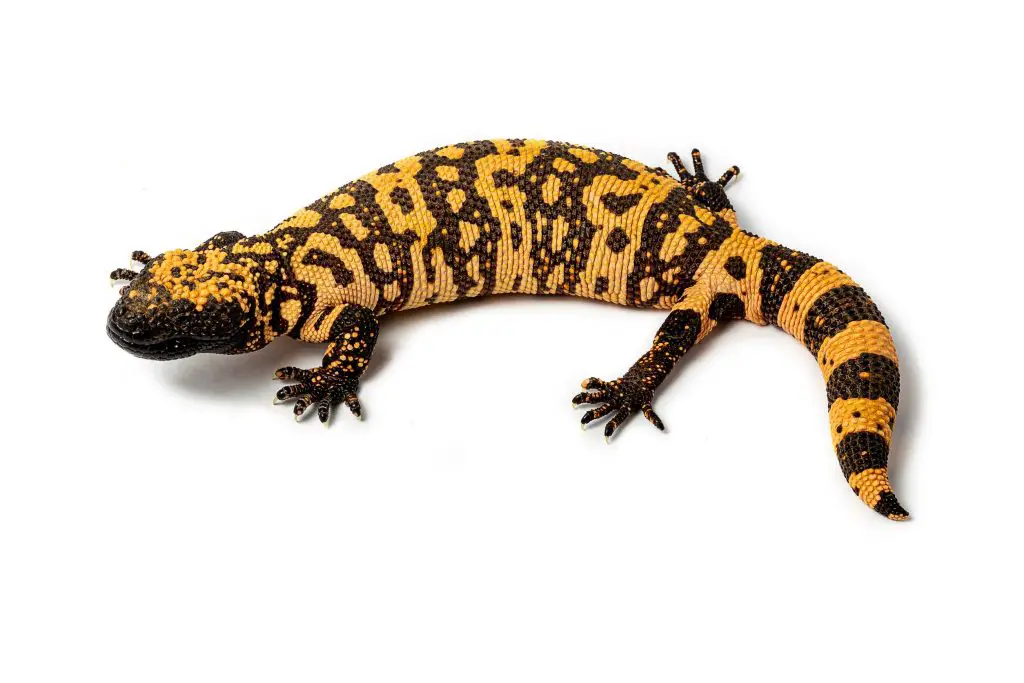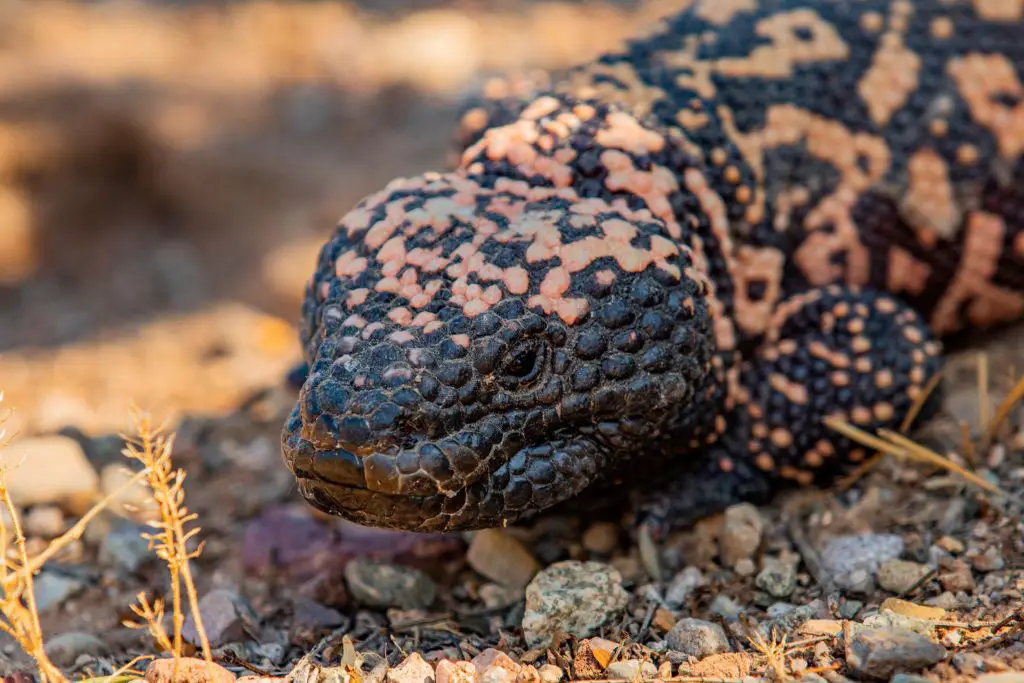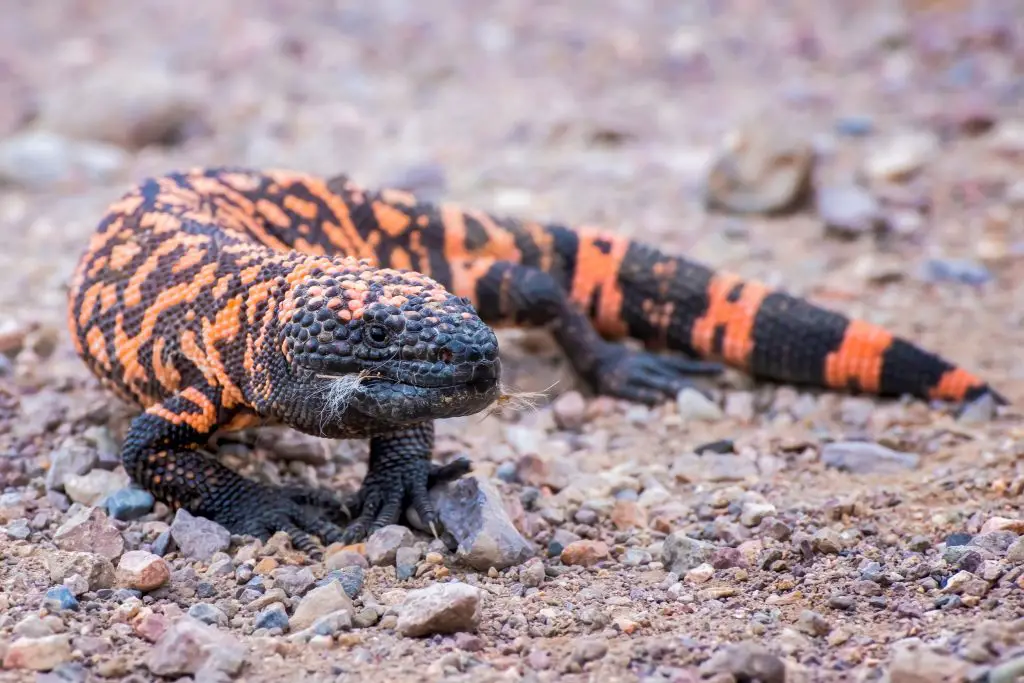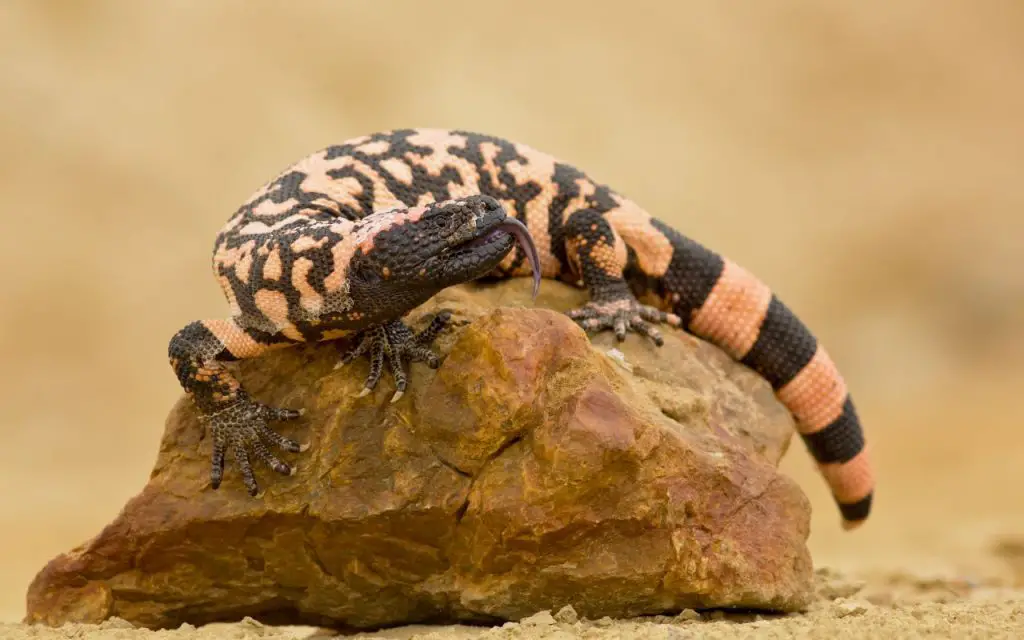If a Gila Monster bites you, you almost certainly won’t die. Nonetheless, it will be a very painful time to get through. Keep reading to find out more…
Last updated on February 1st, 2023 at 09:32 am
If a Gila Monster bites you, you’ll suffer a range of wound and venom-related symptoms. The venom causes intense pain, excessive sweating, and potentially dizziness. The bite itself will also cause some small lacerations, bruising, and bleeding. Generally, you will recover from a Gila monster bite within 24 to 72 hours.
Are Gila Monster bites fatal?
Gila Monster (Heloderma suspectum) bites are not fatal. In fact, this website couldn’t find one single recorded fatality in the last 80 years. The last report was from 1930, and most experts dispute how valid it is. The overally consensus is that it’s unlikely anyone has ever died from Gila Monster envenomation.
The reason for this lack of fatalities isn’t that their venom is weak. In fact, they have very strong venom, which some scientists have compared to that of the Western Diamondback Rattlesnake in its potency.
What Gila Monsters are lacking is the sophisticated delivery system viperid snakes like the Rattlesnake have. It seems that when they do bite, a relatively small amount of venom enters the wound, and it also tends to spread in the cutaneous tissue, rather than enter the bloodstream in any significant quantity.
The reason for this is simple: Rather than hollow fangs that inject venom, these lizards have grooved teeth that venom runs along using capillary action. The result is a slow venom introduction method, that requires a lot of chewing or hanging on.
Nonetheless, it’s important to remember that any bite, from any insect, snake or arachnid can be fatal. An allergic reaction can occur, and if hives (a rash) or any difficulty breathing occur, it requires immediate medical attention for potential anaphylaxis. In this sense, it doesn’t matter if it’s a Gila Monster or a Honey Bee.
What to expect from a Gila Monster bite
The main thing that happens following a bite from this lizard is intense pain, and not just from their venom.
Their bites cause two kinds of pain: mechanical and neurological.
I say mechanical pain because Gila Monsters have a strong, clamping bite and some serious teeth. Bites from them invariably result in nasty lacerations and are more severe than a bite from an adult Ball Python or a Common Boa, for example.
The neurological pain, on the other hand, is caused by their venom. It appears to target nerves and generate a huge amount of localised pain.
Interestingly, the degree of pain felt seems to vary. Some people report extreme, agonising pain, whilst others say they have almost none.
In one reported bite from 1997, the only pain was due to the cuts from the bite itself, despite an oedema indicating that venom was clearly introduced. Check it out for yourself.
In order of severity, the sypmptoms generally include:
- Pain
- Oedema (swelling from fluid build-up)
- Bruising
- Excessive sweating (diaphoresis)
- Dizziness
- vomiting

Gila Monster bite force psi
The exact bite force inflicted by one of these lizards probably varies according to its size, body condition and weight. What is certain, however, is that they are hard to remove. If you get bitten and the animal doesn’t want to let go, you’ll have a hard time getting it off.
One number that gets thrown around a lot is 1200 psi. I couldn’t find the particular study that determined this bite force, but if true it would mean that Gila Monsters have a ridiculously strong, crushing bite.
Note: please get in touch if you can find the study in question – I’ll update the article!
Given that Gila Monsters inject venom slowly through chewing and capillary action, you have a choice if you get bitten: rip them off and get deeper cuts, or let them release in their own time and get more venom!
Gila Monster bite wound
Bite wounds vary a lot by animal, and reason that this type of lizard causes a lot of pain is down to its adaptations.
Despite having very unpleasant venom, the Gila Monster’s method for killing prey is to hold it and crush it. The last thing it wants is for prey to eascape, especially as in the desert where they live you never know when the next meal will be.
To this end it has sharp recurved teeth, that are fixed in place (we call this pleurodont, meaning fused to the jaw bone).
So when one bites you, it’s like having very strong, very sharp fish hooks stick into your finger.
Conversely, the venom itself hurts a lot, but seems to cause no long-term damage. This means treatment usually consists of support for pain, and close monitoring. To date, there is no Gila Monster antivenom in production.

Gila Monster size
Heloderma suspectum is the largest native lizard in the USA, though it does have a larger cousin to the south, the Mexican Beaded Lizard (Heloderma horridum), which can reach a chunky 36 inches (90cm) in length.
Gila Monster size is often exaggerated, though it is true that they can sometimes reach 24 inches (60cm) in length. Generally speaking, they don’t get over 20 inches (51cm) or so, but they’re stockiness makes for an impressive animal nonetheless.
This substantial size allows them to operate with a slow metabolism and store reserves of fat in their tail. The more they’ve eaten over the course of a season, the fatter their tail will be.
Extra fat storage is particularly useful for the Gila Monster as it only encounters most of its favourite foods in spring, i.e. baby bunnies and birds eggs.
In captive situations, this same ability can lead to obesity. (You can learn more about this about this in my Gila Monster husbandry guide)
Gila Monster diet
In the wild, Gila Monsters eat a wide variety of prey, and occasionally even dead animals. They seem to eat a lot in one go, then use the energy gained sparingly. In this respect, they are a lot like some large snakes.
Prey items include:
- Small mammals (such as Kangaroo rats)
- Bird’s eggs
- Nestling birds
- Other lizards
- Insects
- Reptile eggs
- Baby rabbits

What exactly is in their venom?
Gila Monster venom is a complex cocktail of proteins, peptides (like little mini-proteins), and enzymes. We call these various elements toxins, as they are designed to harm the animal/human they are injected into. Surprisingly, some of them also have unexpected pharmaceutical properties.
One peptide present is Helodermin, which is unique to the Heloderma genus, hence its name. Interestingly, one study found that this particular peptide helps to reduce blood pressure – more on this here.
Enzymes are (almost always) proteins that have an effect on chemical reactions within the body’s cells. This is why they are able to increase the sensation of pain in the case of Gila Monster venom.
To our knowledge, the main toxin in Gila Monster venom is Gilatoxin, which has a neurotoxic affect (attacks the nerves). It appears to be geared towards causing as much pain as possible.
Incidentally, Gilatoxin is an effective agent for controlling type 2 diabetes, and may be affective at treating lung cancer.
You can read more about its effect on diabetes here: Exendin-4 from Heloderma suspectum venom: From discovery to its latest application as type II diabetes combatant.
Are Gila Monsters aggressive?
Gila Monsters are not aggressive, and evidence suggests their venom is for defence. The goal is for their bite to be so painful that no animal ever wants to bother them again. They are slow, deliberate animals that will stand their ground but not attack unless completely cornered.
That said, their strike can be very fast, like a quick sideways swipe with their head. Just because they generally move slowly, it doesn’t mean they can’t move quickly!
The different uses of venom in animals:
| Animal | How it uses its venom |
| Honey Bee | defence |
| Gila Monster | defence |
| Platypus | defence and fighting between males |
| Rattlesnake | defence and digesting prey |

The bottom line
These beautiful lizards have a toxic venom, but poor delivery system. If in the southwest, your main concern should be rattlesnakes, which are more than capable of delivery a life-changing bite, with long-term complications.
If herping, take care when lifting rocks, and consider using tools. Wear appropriate boots and protective leg gear if you want to 100% safe. By doing this you can avoid 100% of bites from either Gila Monsters or Rattlesnakes.
All in all, Gila Monster bites aren’t fatal, but any bite should be taken seriously. It may be true that fatalities are almost unheard of, but the best policy is always to avoid being bitten by any animal.
If you’re curious to read more, I suggest you take a look at this detailed medical report generated from a bite by a captive Gila Monster: Report on envenomation by a Gila monster (Heloderma suspectum) with a discussion of venom apparatus, clinical findings, and treatment
FAQ related to Gila Monster bites:
Has a Gila monster ever killed a human?
There is one report from the 1930s of a man who was killed by Gila Monster. But the man was also said to be heavily intoxicated, which is a bad idea out in the desert anyway. So far, there is no reliable report of a human dying from a Gila Monster bite alone.
Are Gila monster bites fatal?
Gila Monster bites aren’t fatal. Their venom doesn’t spread like that of venomous snakes, and the effects are usually mild in comparison. However, an allergic reaction similar to that which some people get from bee stings is always possible. You should never get closer than four feet away from a wild Gila Monster.
Will a Gila monster chase you?
Gila Monsters do not chase people. They do stand their ground though, rather than run away. Overall, most bites reported are defensive. Someone will approach a Gila Monster too closely, or even try to touch one. At this point, the lizard gets scared and lashes out in what it thinks is self-defense.

